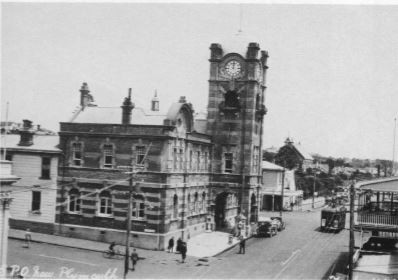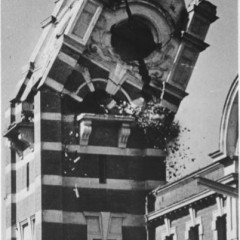7:6
Eventually the debt was paid. The building of the convent was completed in 1886, and for many years the sisters and their pupils lived there on bare subsistence level. They made their own clothes and shoes, and constructed their beds from scraps of timber left by the builders. Mother Mary impressed on the sister to avoid incurring unnecessary expense, but in doing so 'not to deprive them of the necessities of life but to economise and practise real poverty. The land on which the old convent stood had several owners before the sisters acquired it. The original grant was made to Sergeant John Dunn, following the cessation of the land wars: the deed for Town Allotment No. 671, signed by Governor Grey, bore the seal of Queen Victoria's 'Our Colony of New Zealand', and was dated 20 October, 1868. Dunn must have beaten the gun, for he sold part of the land to George Tunnecliff a publican, for $40 in 1861, and the rest a few months later to Frederick Windsor 'gentleman' for $50. Tunnecliff sold his holding to Windsor 'together with a dwelling house and all other buildings' for $400, and the property changed hands several more times before the Sacred Heart Order acquired it. By the turn of the century Mother Mary records: 'The sisters found life much easier and were able to have greater contact with parents of the children.' One of the main problems was the lack of space for outdoor activities. Additional ground was acquired, including a house belonging to the Honeyfield Estate next to the convent. The house was converted into a primary school, allowing room in the main convent for the increasing number of secondary pupils. This corner is now the site of the Shell, BP and Todd oil consortium. The large, three-storeyed wooden convent gave religious and secular education to thousands of girls over the years, but by the 1960s it was obvious that the ancient structure was approaching the end of its days. It was becoming an increasing fire risk, maintenance and repairs were becoming more expensive, there were complaints that the whole structure shook alarmingly during high winds, and the sisters and pupils were often required to place buckets and pails to catch rainwater from the leaking, rusty roof. In September 1973 demolition began. The section on which the convent stood was sold to the Salvation Army. In the meantime the new Sacred Heart College had been opened in 1961 on eight hectares of land off Pukaka Street, Fitzroy, which had been acquired by the Order in 1920 and had been leased to farmers. This college, built for $290,000 and its neighbour, the Sacred Heart Convent, built in 1971, provided accommodation for 30 sisters, about 80 boarders, and education for more than 300 girls, some of whom were non-Catholic. Associated with these projects was the new St John Bosco primary school just across the railway line from Sacred Heart. This had been in use from 1942, and every Friday was 'converted' into a church until the new Church of the Lady Help of Christians was opened in June, 1958.
Catholic primary schooling for boys and girls was first offered by Miss Oakley, which served the needs of the parish until Rolland Hall was opened in Devon Street in the 1890s. This proved early in its life that it was far too small, and in 1907 StJoseph's School, to accommodate about 100 pupils, was built on the corner of Powderham and Mt Edgcumbe Streets. It was 'a very comfortable and well-equipped facility' 35 but this, too, soon outgrew its capacity and in 1926 the present St Joseph's Primary School. (known as Heidelberg in the early years) was built, where boys and girls up to Standard Four level were taught. Catholic parents in New Plymouth who wished to continue their children's education with a religious background were faced with a dilemma prior to 1959. On leaving Catholic co-educational schools, girls could be accommodated at Sacred Heart. But the boys had no similar facility and many were boarded out in Catholic education centres in other towns. The move to start a fund for a Catholic boys' college began on June 3, 1946, when Father P. J. Minogue, Parish Priest, formed the Francis Douglas College Association. At a meeting attended by more than 500 in the Regent Theatre on July 28, $7000 was collected, the nucleus ofa fund to establish a college to cater for 600 boys from Form One to Form Six. Various sites were considered, including land occupied by St Joseph's Primary School in Calvert Road; the old girls' convent, and several areas in the town centre. In June, 1947, the executive of the Francis Douglas Association announced it had brought from' Mr Huggard a property in Westown, New Plymouth, to be the site of the new college. It is 21 acres in extent and there is ample level or levellable land available for building and playing areas and ample scope for further development. '36 After 12 years of campaigning $514,000 had been raised, leaving $136,000 to meet the total cost, which was attained a few months after the college was opened by Archbishop P. T. B. McKeefry, on September 13, 1959. The college was named as a memorial to Father Francis Vernon Douglas who had been a curate in New Plymouth from 1934 to 1936. A popular priest, he became interested in missionary work in Asia and in 1938 was appointed to the Columban Missions in the Philippines where he was assigned to a parish in the tiny town of Pi lilla, about 40 kilometres through the jungle north of Manila. In 1942 the islands were over-run by the Japanese.
On July 24 Father Douglas, then aged 30, was arrested by the Japanese and was subjected to terrible torture and mutilations during interrogation aimed at revealing the whereabouts of parishioners who had acted as jungle-based guerilla fighters, and who were alleged to have come to confess to Father Douglas. He refused to give information, and tortures which were carried out in front of the altar of his little church-were intensified. He was last seen, weak and almost unconscious, being thrown into a truck by soldiers carrying rifles with fixed bayonets. The place of his death was never found.
'I admire the man', said one Japanese soldier. 'He knows how to suffer. Father Douglas made only one request: for a priest to whom he could make his confession. Surprisingly the request was granted on condition a Japanese soldier was present. The priest, Father Rosedale, a Filipino, told afterwards that he had found Father Douglas in a pitiful state, covered with blood and wounds from head to foot, one eye missing and terribly damaged. In February, 1952, St Pius X School, in Brooklands Road, was opened by Archbishop McKeefry, with a roll of 74 primary pupils. This marked a new educational development in staffing Catholic schools in the town: it brought a new order of religious teachers, St Joseph. This order had been established in Australia in 1835 by Father Tennison Woods and Mother Mary of the Cross (Mary McKillop, of Scottish extraction). Its aims included charity and education-especially for poor children-and it had only two centres in the Wellington diocese at Waiwhetu and Brooklands. The school was used as a mass-centre for the newly formed St Philomena's parish at Brooklands and Vogeltown, and in 1972 it was extended to cater for a roll of 120. It has made a strong spiritual, academic and sporting contribution to Sacred Heart and Francis Douglas Colleges' intermediate and secondary departments.
The first free kindergarten in New Zealand was opened in Dunedin in 1899 and although other pre-school education centres followed in that city, it was not until the 1930s that the movement assumed prominence in the rest of the country. New Plymouth's first kindergarten was opened in 1950 in the Frankleigh Park Hall, since when seven other centres have been established in various suburbs.
As in many other towns and cities in New Zealand problems associated with the education, training, and care of handicapped children were not always conducted with sympathy, understanding nor even intelligence. In 1950 a group of parents in the town who either had handicapped children, or who were sympathetic to their cause, formed the New Plymouth Intellectually Handicapped Children's Society. An educa- tional group comprising nine pupils was started in the Whiteley Hall with Mrs Dorothy Barnett as teacher. Two years later the group moved into St Mary's Hall, Vivian Street, and $40 was paid to the church committee for a wash-basin in lieu of six months' rent. Other changes of venue included St Andrew's Presbyterian Hall in 1955. When the New Plymouth Rotary Club donated a house property at 49 Leach Street, the group moved to this address with 14 pupils.
The Taranaki Education Board established the Roselyn School at Westown in 1959 and the Leach Street property was used as a workshop for senior boys and girls. In the mid-1960s a 2 ha property was bought in Davies Road and two years later a new opportunity workshop, Atawhai, was opened by the Minister of Social Welfare, N. J. King. The association's name was changed in 1975 to the Taranaki Branch of the New Zealand Society for the Intellectually Handicapped, because of the growing number of adult handicapped people, who also used the workshop.
The branch had more than 140 people in its care in 1980.
Education in New Plymouth has had its critics. There have been problems; there have been errors and omissions; there have also been triumphs. Many thousands of concerned people have served on countless school committees, parent-teacher associations, education boards, and as teachers and administrators. A statement by H. R. Richmond, Superintendent of the Taranaki Provincial Council and chairman of the first Taranaki Education Board, was as pertinent in 1980 as it was when it was made in 1868: 'In education we effect nothing unless the community works with us ... it is salutary to remember that administration ends at the classroom door; and the real business of a school is his teacher working with his pupils.

